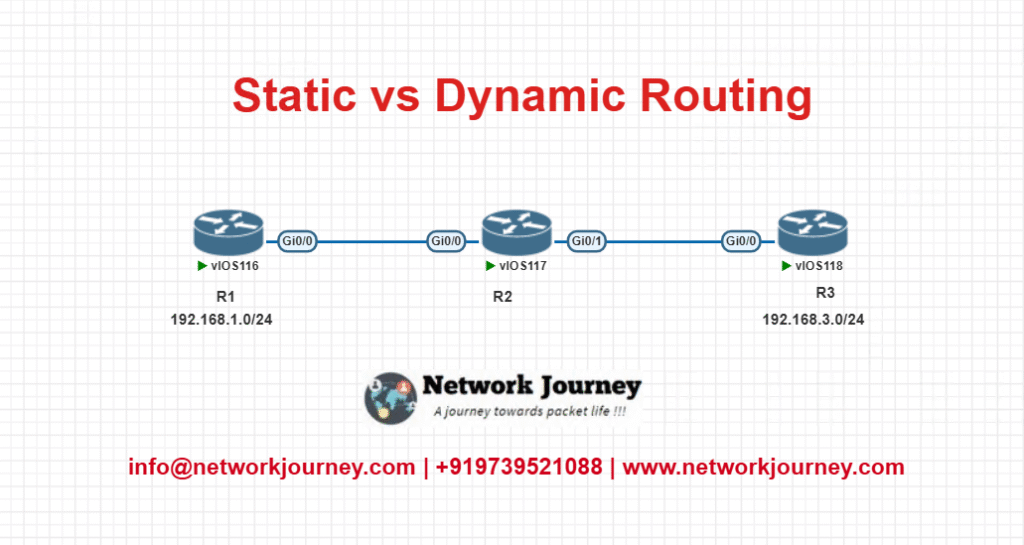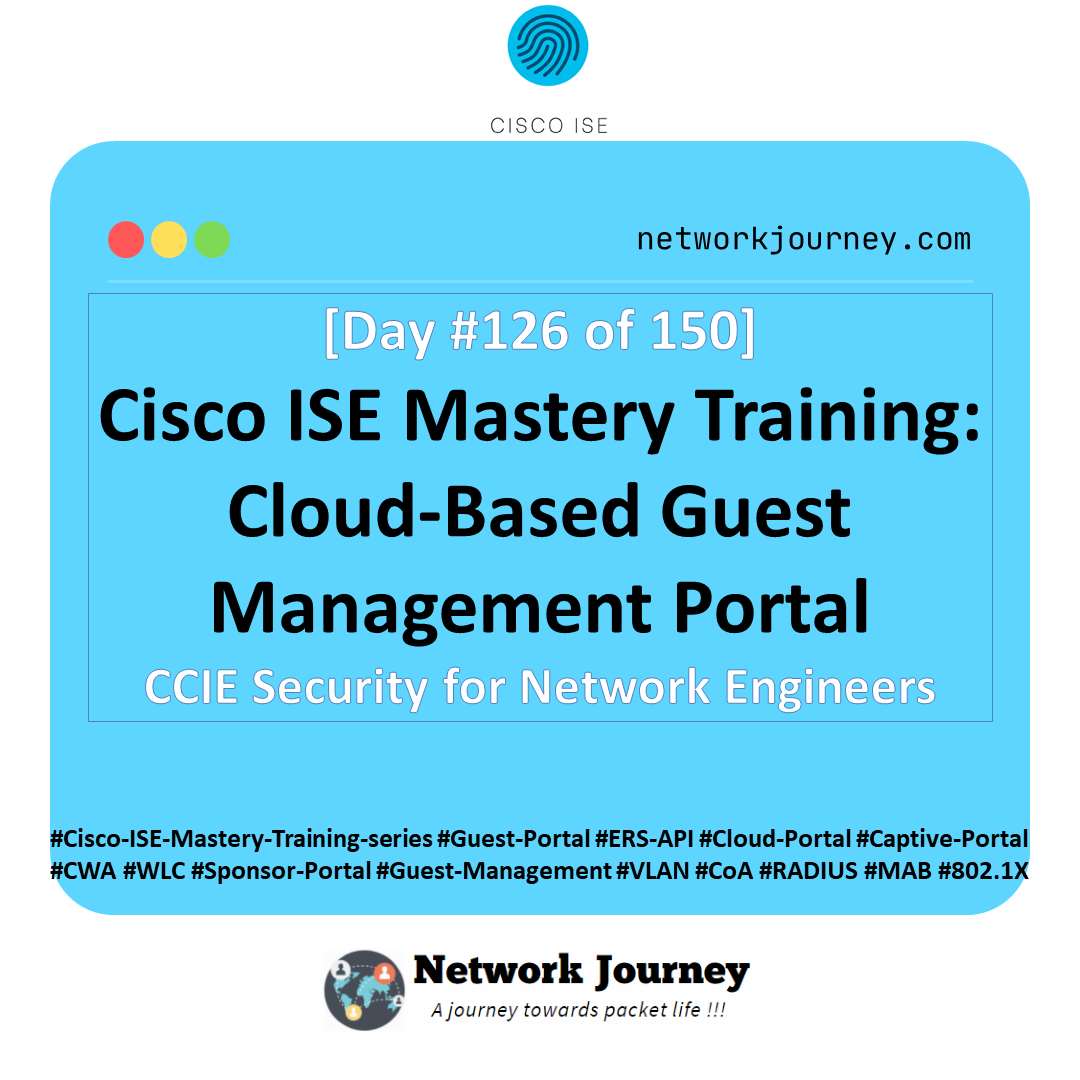Static vs Dynamic Routing – Which One Should You Trust in Real Networks? [CCNP ENTERPRISE]
“Should I use static or dynamic routing here?” — welcome to a real-world networking dilemma.
When I started out in the networking field, I leaned heavily on static routes because they were simple and easy to control. But as networks grew more complex, I quickly saw the power of dynamic protocols like OSPF and BGP. Over time, I learned that the best engineers don’t pick one over the other — they know how and when to use both.
In this blog, we’ll explore static vs dynamic routing in a clear, hands-on way. You’ll get:
- Simple theory breakdown
- Pros and cons in a visual comparison
- Useful CLI commands
- A mini EVE-NG lab you can try at home
- Real-world use cases
- Troubleshooting tips
- And answers to FAQs that every learner has at some point.
Let’s get started — NetworkJourney style!
Table of Contents
Theory in Brief – Static and Dynamic Routing Explained
Static Routing – The Manual Way
Static routing is where you manually configure a route on a router to tell it how to reach a destination network. The route stays in place unless you remove or modify it.
It’s great for:
- Small or simple networks
- Backup or fallback routes
- Situations requiring full control
But the biggest drawback? If a link goes down, the router won’t adapt unless you manually change the route.
Dynamic Routing – The Smart Way
Dynamic routing is where routers exchange routing information using routing protocols like:
- OSPF – Open Shortest Path First
- EIGRP – Enhanced Interior Gateway Routing Protocol
- RIP – Routing Information Protocol
- BGP – Border Gateway Protocol
These protocols allow routers to learn, share, and adjust routing decisions based on network conditions like link failures, path cost, etc.
It’s ideal for:
- Medium to large networks
- Multi-branch environments
- Networks that need high availability
The Core Difference?
Static routing = predictability.
Dynamic routing = adaptability.
Comparison: Static vs Dynamic Routing
| Feature | Static Routing | Dynamic Routing |
|---|---|---|
| Configuration | Manual entry | Automatic with protocols |
| Scalability | Low – not ideal for large networks | High – best for enterprise networks |
| Failover Support | Manual rerouting needed | Auto rerouting available |
| Security | More secure, no advertisement | May need authentication and filtering |
| Complexity | Low | Medium to high (depends on protocol) |
| Maintenance Effort | Higher over time | Lower once deployed properly |
| CPU/RAM Usage | Minimal | Moderate to high |
| Convergence Time | No convergence – manual | Fast (OSPF/EIGRP) or slow (BGP) |
Pros and Cons
| Type | Pros | Cons |
|---|---|---|
| Static | – Simple and predictable – Resource-efficient – Secure | – No auto-failover – Tedious for large networks – No scalability |
| Dynamic | – Auto route learning – Supports failover – Scales well | – Protocol complexity – Consumes resources – Risk of loops if misconfigured |
Essential CLI Commands
| Device/Protocol | Command | Purpose |
|---|---|---|
| Cisco IOS (Static) | ip route 192.168.2.0 255.255.255.0 10.1.1.2 | Add a static route |
| Cisco IOS | show ip route | View the full routing table |
| Cisco IOS | show ip protocols | Check protocol status and timers |
| OSPF | router ospf 1network ... area 0 | Start and configure OSPF |
| OSPF | show ip ospf neighbor | View neighbor relationships |
| EIGRP | router eigrp 100network ... | Start and configure EIGRP |
| BGP | router bgp 65001neighbor x.x.x.x ... | Start and configure BGP |
| BGP | show ip bgp summary | Check BGP peer status |
Real-World Use Cases
| Use Case | Preferred Routing Type | Why? |
|---|---|---|
| Branch office with single uplink | Static | Simple setup, fewer changes |
| Multi-site enterprise network | Dynamic (OSPF/EIGRP) | Auto-updates, resilience |
| MPLS or leased line connections | Static or BGP | Precise control or ISP-level route exchange |
| Internet routing between ISPs | BGP | Internet-scale dynamic policy routing |
| Cloud VPN connections | Static | Secure and predictable routing |
| WAN with dual ISP failover | Static + Dynamic | Combine control with redundancy |
EVE-NG LAB – Static and Dynamic Routing in Action
Lab Topology

We’ll:
- Use static routing from R1 to R3
- Use OSPF between R2 and R3
Configuration
R1 (Static Routing)
interface g0/0
ip address 192.168.1.1 255.255.255.0
no shutdown
ip route 192.168.3.0 255.255.255.0 192.168.2.2
R2 (Middle Router)
interface g0/0
ip address 192.168.1.2 255.255.255.0
interface g0/1
ip address 192.168.2.2 255.255.255.0
interface g0/2
ip address 192.168.3.1 255.255.255.0
router ospf 1
network 192.168.3.0 0.0.0.255 area 0
network 192.168.2.0 0.0.0.255 area 0
R3 (Dynamic – OSPF)
interface g0/0
ip address 192.168.3.2 255.255.255.0
router ospf 1
network 192.168.3.0 0.0.0.255 area 0
Test Connectivity:
- From R1:
ping 192.168.3.2 - On R2:
show ip ospf neighbor - On R3:
show ip route
Try shutting a link and observe behavior between static and dynamic routes.
Troubleshooting Tips
| Issue | Likely Cause | Command to Use | Routing Type |
|---|---|---|---|
| Route missing in table | Wrong mask, next-hop down | show ip route, ping | Static |
| OSPF neighbor not formed | Mismatched area or hello timers | show ip ospf neighbor, debug | Dynamic (OSPF) |
| Route loops | Incorrect manual routes | traceroute, show ip route | Static |
| Network unreachable | Missing redistribution | show ip protocols | Mixed |
| BGP peer not established | TCP session blocked or config | show ip bgp summary | Dynamic (BGP) |
Frequently Asked Questions (FAQs)
1. What is the Main Difference Between Static and Dynamic Routing?
Answer:
- Static routing is manually configured by the administrator. The route never changes unless updated manually.
- Dynamic routing uses protocols like OSPF, EIGRP, or BGP to automatically learn and update routes based on network changes.
Think of static routing as GPS with no live updates, while dynamic routing is traffic-aware navigation.
2. When Should I Use Static Routing Over Dynamic Routing?
Answer:
Use static routing when:
- You have a small or stable network.
- You need tightly controlled traffic paths.
- You want maximum predictability and security.
Examples:
- Point-to-point links, stub networks, backup paths (with higher administrative distance), or connecting to a static ISP gateway.
3. What Are the Advantages of Dynamic Routing in Larger Networks?
Answer:
Dynamic routing offers:
- Automatic route learning and updates.
- Faster convergence in case of failure.
- Scalability – useful in large or changing environments.
- Load balancing in certain protocols like EIGRP.
This makes dynamic routing the go-to solution for enterprise and service provider networks.
4. How Does Administrative Distance Help in Choosing Between Static and Dynamic Routes?
Answer:
Administrative Distance (AD) is the trust level of a route source. Lower AD = higher preference.
| Routing Type | AD Value |
|---|---|
| Connected | 0 |
| Static | 1 |
| EIGRP | 90 |
| OSPF | 110 |
| RIP | 120 |
A static route (AD 1) will always override a dynamic one (unless manually adjusted). You can tweak AD to create backup scenarios — primary dynamic, static as fallback (or vice versa).
5. Can Static and Dynamic Routing Be Used Together?
Answer:
Yes, and this is common in real networks. For example:
- Use dynamic routing for internal LAN/WAN.
- Use static routing for default routes toward ISPs or DMZs.
- Configure static routes with higher AD as a backup if the dynamic protocol fails.
This hybrid model gives control and flexibility.
6. What Are the Security Implications of Static vs Dynamic Routing?
Answer:
- Static routing is more secure since it doesn’t exchange routing info over the network.
- Dynamic protocols can be vulnerable if not secured properly (e.g., OSPF/BGP without authentication).
However, protocols now support MD5 or SHA authentication, and route filtering for added control. In high-security environments, static routes are often used at perimeter interfaces.
7. Which Routing Protocols Should I Learn for Dynamic Routing in CCNP Enterprise?
Answer:
Focus on:
- OSPF – Link-state, widely used in enterprise networks.
- EIGRP – Cisco proprietary, very fast and efficient.
- BGP – Exterior routing for internet and MPLS.
- RIP – For understanding basics, not commonly used in production.
The CCNP Enterprise exam expects you to configure, troubleshoot, and compare these protocols with precision.
8. How Do I Troubleshoot a Static Route Not Working?
Answer:
Check the following:
- Is the next-hop IP reachable (ping test)?
- Is the outgoing interface up?
- Are there overlapping or conflicting routes?
- Is the static route’s AD lower than dynamic routes?
Use commands like:
show ip route
show ip interface brief
show running-config
These will help verify configuration and reachability.
9. What’s the Impact on Convergence Time in Static vs Dynamic Routing?
Answer:
- Static routes don’t detect failures automatically — convergence is manual unless enhanced with tracking (e.g., IP SLA).
- Dynamic protocols detect failures via hello/dead timers or BFD and converge automatically.
If fast failover is a requirement, dynamic routing (or static routes with IP SLA tracking) is preferred.
10. In Real Enterprise Deployments, Which Is More Reliable – Static or Dynamic Routing?
Answer:
Both are reliable — it depends on the use case.
- Use static routing when the path is simple, predictable, or requires tight control (e.g., to an edge firewall).
- Use dynamic routing when the network is complex, redundant, and evolving.
A seasoned network engineer uses both intelligently, often combining them with failover mechanisms and policy-based routing to ensure high availability and performance.
YouTube Lab – Watch Routing in Action
Watch the Complete CCNP Enterprise: Static vs Dynamic Routing – Which One Should You Trust in Real Networks? Lab Demo & Explanation on our channel:
Final Thoughts – Choose Smart, Not Just Simple
Here’s the takeaway I give to every NetworkJourney student:
Use Static Routing when you want control, simplicity, and predictability.
Use Dynamic Routing when you need scalability, automation, and failover.
Use both where it makes sense — that’s what real network engineers do.
As always, don’t just read — LAB IT OUT. Use EVE-NG or Packet Tracer, play with scenarios, and build the logic behind every command.
Final Note
Understanding how to differentiate and implement Static vs Dynamic Routing – Which One Should You Trust in Real Networks is critical for anyone pursuing CCNP Enterprise (ENCOR) certification or working in enterprise network roles. Use this guide in your practice labs, real-world projects, and interviews to show a solid grasp of architectural planning and CLI-level configuration skills.
If you found this article helpful and want to take your skills to the next level, I invite you to join my Instructor-Led Weekend Batch for:
CCNP Enterprise to CCIE Enterprise – Covering ENCOR, ENARSI, SD-WAN, and more!
Get hands-on labs, real-world projects, and industry-grade training that strengthens your Routing & Switching foundations while preparing you for advanced certifications and job roles.
Email: info@networkjourney.com
WhatsApp / Call: +91 97395 21088
Upskill now and future-proof your networking career!
![Static vs Dynamic Routing – Which One Should You Trust in Real Networks? [CCNP ENTERPRISE]](https://networkjourney.com/wp-content/uploads/2025/06/Static-vs-Dynamic-Routing–Which-One-Should-You-Trust-in-Real-Networks_networkjourney-1.png)


![Want to Stop Unauthorized Access? SSH and HTTPS Hardening Explained[CCNP ENTERPRISE]](https://networkjourney.com/wp-content/uploads/2025/07/nj-blog-post-ssh-https.jpg)